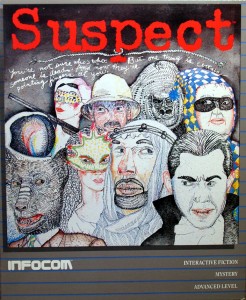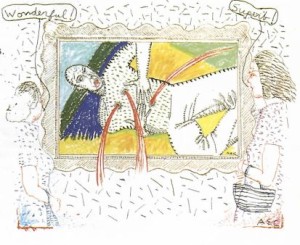(Warning: this article includes some spoilers.)
And finally there was Suspect. Dribbled out into Hitchhiker’s huge wake just as 1984 expired, David Lebling’s first exercise in ludic mystery and Infocom’s fifth title of 1984 still carries with it a certain inevitable air of the anticlimactic. But we always try to give every Infocom game its due around here, and Suspect will be no exception.
If you’ve played Deadline or The Witness, or even just read about them, you have a pretty good idea of what to expect from Suspect. Once again this is a game that you must not so much explore as dissect; must not work your way through linearly from introduction to climax but rather assault from every angle. You can expect to finish it successfully only after dozens of restarts, each of them a little fact-finding mission all its own. Then, when you’ve seen all the pieces, you can fit them together and plan your final mission, at the end of which you will hopefully walk away with a guilty verdict (on someone other than yourself, that is). That’s the ideal, anyway; more likely the first few times you try you’ll find you still don’t quite have enough evidence, and thus it’s back to restarting and looking for more.
Suspect completes a neat trilogy of mystery roles. In Deadline you played the detective investigating a murder; in The Witness a witness to a murder; and in Suspect, yes, the prime suspect in a murder. You play a newspaper reporter who’s invited by Veronica Ashcroft, a Maryland blue blood and old friend from university, to her annual Halloween bash. Soon after your arrival Veronica is found murdered in her office — offices are dangerous places in Infocom mysteries; that’s where the crime in all three of them takes place — with the lariat that goes with your cowboy costume wrapped around her neck. You have to find the real murderer before the detective that comes to investigate and his associate, your old friend Sergeant Duffy, arrest you for the crime.
While Suspect, like The Witness, hews very firmly to the sturdy template laid out by Deadline, it does reflect Infocom’s ever-growing sophistication. There are far more characters to interact with than in the earlier games, and far more to see and do. Indeed, the world of Suspect is in many ways the most complex Infocom had yet created. Every character in the game is constantly moving about the rather expansive grounds of Veronica’s estate, and they mostly react believably to events around them, whether said events are set off by you or someone else. Granted, it is kind of odd that no one seems to care all that much when they learn that Veronica’s just been murdered, to the extent that they just continue enjoying Veronica’s own party despite her unfortunate absence. Then again, exactly this sort of behavior is par for the course in many an Agatha Christie novel, so I suppose we can take it as in the spirit of the genre.
Dave Lebling is generally a deft, elegant writer. He doesn’t entirely let us down here, but he is somewhat hampered by the need to describe so many comings and goings. It can all begin to have something of a mechanistic feel, as if all these characters were models moving about the house on tracks.
>s
Long Hall South
This is almost the southern end of the long north-south hall. A large doorway opens into the southern end of the ballroom. Another door on the west is to a small closet.
Ostmann is off to the east.
Alicia heads off to the east.
Smythe heads off to the north.
>s
Long Hall Begins
Here the front hall and a long north-south hall fronting the ballroom intersect. Another hall starts south of here and goes east.
The Werewolf is to the west, heading toward the east.
Linda is to the west, heading toward the east.
Smythe is to the north, heading toward the south.
In his defense, Suspect is hardly alone among Infocom’s mysteries in having this wind-up-toy feel about it. The very depth of the simulation tends to cut against their literary sensibilities.
Still, Suspect also has room for whimsy. Lebling gifts us with more Easter eggs and in-jokes than any game this side of Sorcerer. Shout-outs for hardcore fans are everywhere. One of the party-goers is dressed as a “short, cuddly-looking robot”; another is a grue; moving a rug aside gets you “Under the rug you see a wooden trap door… No, sorry! That’s another story.” Indeed, the more superficial elements are some of the most entertaining. The game is a little time capsule of yuppie life in the early 1980s, from the BMW 320i in the garage to “Karma Chameleon” playing in the ballroom.
The charm extends to the feelies, the main exhibit of which is a little Miss Manners-style guidebook called Murder and Modern Manners. The humor therein bites a bit more sharply than was the norm for Infocom, with at least one paragraph that qualifies as genuine satire, on the subject of “Prison Projects”:
Poetry can be a wonderfully sensitive medium for expressing your remorse and anguish. The study of law will help you improve your oratory skills, a clear benefit when you make vehement pleas to the prison parole board. Writing books can also be quite rewarding: the first eight editions of this book were all highly successful and sold particularly well among guilt-ridden liberals. But perhaps the wisest choice is painting. Prisoners are perceived as having great depths of repressed artistic genius. There are literally thousands of deep-pocketed dilettantes who are willing to pay a fortune for prison art. Especially if the work is being done by prisoners with a background of violent crime.
Infocom and G/R Copy were able to enlist a name artist with a long history in high and commercial art, Alan E. Cober, to illustrate the box and the booklet in his distinctively spare, modern style. The economic woes that would beset the company very soon after Suspect would make such prestigious collaborators a thing of the past.
The actual mystery at the heart of it all is intriguing, if also damnably difficult to crack. Suspect is in fact the second very tough Infocom game in a row, following seven very solvable titles between Suspended and Hitchhiker’s. (Hitchhiker’s and Suspect together are almost enough to make me revise my premise that Infocom games trended generally easier as the company grew older.) When you put together the clues which are laced very subtly through the text and the storyworld to divine who’s responsible and how he, she, or they committed the crime, it’s a wonderful moment. Unfortunately, that’s just the first step. Actually proving what you know to the detective’s satisfaction is something else, a task made even more difficult by a lack of feedback; you never really know how close you actually are or which bits and pieces you’ve presented to the detective are actually important. It’s particularly difficult to figure out that you need to monitor one absolutely vital thing, the changes in the weather, and hard to know how to ply the detective with that information afterward. In spite of it all, I almost managed to solve the murder in my recent playthrough, aided no doubt by vague memories from years ago. I just neglected to do one key thing and therefore was short one key clue. I “EXAMINE”d Veronica’s party mask, but never “SEARCH”ed it. If this strikes you as rather a cheap move on the game’s part, I can’t say I disagree.
The final solution to the case doesn’t hang together quite as tightly as I’d like it to, a problem Suspect oddly shares with both of the mysteries that preceded it. I kept trying to find a good reason for Alicia to help Michael murder his wife; as the game itself says if you attempt to arrest her alone, she didn’t have any motive. I naturally suspected an affair between Michael and Alicia, but could find no evidence of this beyond seeing them dancing together briefly in the ballroom. Just as happened with both Deadline and The Witness, I was rather shocked when I secured a conviction. I thought there must still be more to discover.
Suspect would turn out to mark the end of the line for Infocom’s original, hardcore take on the interactive mystery novel. While they would continue to dabble in mystery, the later games would play more like conventional adventure games. It’s hard to say why a form that caused such excitement back when Deadline first appeared should peter out so relatively quietly. Certainly it’s clear that a significant number of Infocom fans, both then and now, dislike the form of play of the early mysteries intensely, even if enough enjoyed the format — or just let brand loyalty overcome their misgivings — to generate for Suspect fairly typical sales numbers for its period, just shy of 50,000 copies. But there was also perhaps something else: a feeling that, having invented the format with Deadline, Infocom didn’t quite know how to advance it. For all its additional polish, there’s nothing really new that Suspect brings to the table. It would be unfair to say it feels stale precisely, but it shares enough with its predecessors that it can feel a bit anonymous in their company. Suspect is certainly the least loved and least remembered of the three today. Of course, Infocom might have tried to shake up the approach with a hypothetical next game instead of abandoning it; just having the victim not be a blue blood and not die in her office would make a good start. But being as they never did, we’re left with a trilogy of games almost unique in adventuring history, and one which even comes with an overarching thematic progression. The only other role left for the player to enact was that of victim — and I’m not sure how Infocom could have managed that. Maybe by putting the whole format out of its misery, as they did.
An inevitable footnote to any discussion of Suspect must be the gala that Infocom held to promote it at the January 1985 CES. It was by far the largest party the company ever gave, yet another marker of the high-water point this period represents. They invited some 5000 people to the Hartland Mansion in Las Vegas, formerly one of Elvis Presley’s homes, for what must be the largest game of How to Host a Murder ever played. Customized letter openers, previously mailed to invitees, served for tickets as well as party favors; these are today one of the most cherished of all pieces of Infocom memorabilia. One of these also became the murder weapon, in a crime staged by an acting troupe in front of the crowds gathered in the mansion’s ballroom around a huge indoor pool. The next day’s Las Vegas Sun bore the headline “Murder Rocks CES!,” with the important detail that it was all just pretend hidden below the fold. It seemed like great publicity — until it prompted authorities to investigate, whereupon they determined that the house had not been zoned for hosting a public event of such a magnitude. Infocom was forced to return to Las Vegas to testify in court, but thankfully the owners of the house bore the brunt of the pain. Not as sexy as murder, perhaps, but such is life in the real world.
(As usual at this time of year, The Digital Antiquarian will be taking a little hiatus while my wife and I travel back to the good old U.S.A. for Thanksgiving with my friends and family. Will be back at it in two to three weeks, at which time we’ll shift back over to Britain to look at 1984 there. I’ll see you guys then.)











